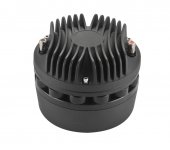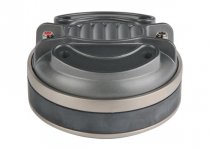Do you think it would be possible for a hobbyist? What would be the biggest obstacle in building such thing?Improved phase plugs may help this situation, but little to nothing is known about the flatness of driver exit waveforms. About a decade ago I showed (B&C) how this situation could be measured in a PWT, but it was never followed through.
...the confirmation that 1,4" drivers can be used without a problem... Many of the modern ones seem to be quite good.
Alex Voishvillo has published data in the AES on the wavefront flatness of the 2430K (1.5") used in the JBL M2 monitor.
It was pretty textbook flat, so there is some data on this.
The pictures were presented without any discussion of how they were determined, IIRC.
I assume it was done in a plane wave tube by mode expansion, the basic idea is not so different from the Klippel scanner mode expansion in 3d.
There is a very informative thread on the Klippel scanner maths in Audio Science Review, after an earlier thread in DIYaudio fizzled out.
Best wishes
David
Last edited:
I'd really love to play around with the JBL 2409H and the 2410H but they're not easy to buy. (Not for sale at retail.)
The 2409H is in the JBL 705P and it has a 16mm throat (21,250Hz)
The 2410H is two years newer, and it has a 25mm throat (13,600Hz)

The phase plug of the 2410H extends all the way into the horn.
This makes me wonder if the latter solution worked better than the former solution.
These are shown and hopefully demoed at ISE, which I'll be visiting this afternoon. Hopefully I can avoid unprotected contact with farm or wild animals
"The Chinese friends" offered me some drivers for evaluation, but I had to magnetize those myself. Unfortunately they didn't bring "their big guns", like those attached.
The 18Sound clone is sold under DS18 moniker with pure Titanium diaphragm, but it's also available with a Composite Aluminum diaphragm.
The grey one is more or less similar to the Denovo Audio BA-750, sold by diysoundgroup.
Attachments
Last edited:
I would have something like this in mind - seems like a nice project, relatively simple but interesting enough: Acoustic Vector Network Analyzer
This might also be of interest: On the Velocity Distribution at the Interface of Horn Driver and Horn
"A measurement setup was presented that allows accurate measurements of pressure and velocity distributionswithin the junction area of horn driver and horn."
"On the Velocity Distribution at the Interface of Horn Driver and Horn" Preprint Number: - 6097 - Convention: 116 (May 2004) Authors: Behler, Gottfried K.; Makarski, Michael
- So, isn't this solved already?
"A measurement setup was presented that allows accurate measurements of pressure and velocity distributionswithin the junction area of horn driver and horn."
"On the Velocity Distribution at the Interface of Horn Driver and Horn" Preprint Number: - 6097 - Convention: 116 (May 2004) Authors: Behler, Gottfried K.; Makarski, Michael
- So, isn't this solved already?
Last edited:
When I saw this paper at AES I swear they were using a wire microphone which measures velocity not pressure. In theory a two plane idea should work, but I would be concerned with measurements unless the mic was extremely small.
Really there are many ways to solve this problem and which works best remains to be seen, but none have actually come to be widely used and as such there is no data on performance.
Really there are many ways to solve this problem and which works best remains to be seen, but none have actually come to be widely used and as such there is no data on performance.
They mention B&K 4138 (~3.2 mm) or Sennheiser KE-4 (~5 mm). So if a 5 mm electret capsule should suffice (?), I'm quite tempted to try at least, even if I should move the driver manually on some primitive frame - that would cost next to nothing. Your technique looks most interesting and I would prefer that, I'm only scared of the math involved - not something I could cope with in a case of any trouble. This is the complete opposite - can't be any simpler.
Last edited:
I could help with the math, let me find my notes. The biggest issue would be the matrix inversion as these can be problematic. One would likely need to use SVD, but algorithms for that are widely available these days. If you are comfortable with matrix inversion and SVD then I don't think that you would have a problem.
The Makarski technique uses a free field driver, correct? That would bother me as this is not the boundary condition that the driver would see in practice.
The Makarski technique uses a free field driver, correct? That would bother me as this is not the boundary condition that the driver would see in practice.
We already touched that, if that's what you mean: #394, #395
OK, why not to try (both). I already looked for some aluminum tubes around, I can get 25 and 35 mm of inner diameter, up to 6 m long. I'd start a new thread when I have it ready (one mic only for the start).
OK, why not to try (both). I already looked for some aluminum tubes around, I can get 25 and 35 mm of inner diameter, up to 6 m long. I'd start a new thread when I have it ready (one mic only for the start).
Yeah, that puzzles me as well. But neither the tube is...(?)The Makarski technique uses a free field driver, correct? That would bother me as this is not the boundary condition that the driver would see in practice.
Last edited:
I found this one, which also references the Magalotti paper. For $33 I could buy most if not all of the material to actually build the PWT, I guess 
AES Information Document for Acoustics - Plane-Wave Tubes - Design and Practice
AES Information Document for Acoustics - Plane-Wave Tubes - Design and Practice
I found this one, which also references the Magalotti paper. For $33 I could buy most if not all of the material to actually build the PWT, I guess
AES Information Document for Acoustics - Plane-Wave Tubes - Design and Practice
I'll buy you an AES membership if you like, I've certainly got $125 worth of use from your software
They mention B&K 4138 (~3.2 mm) or Sennheiser KE-4 (~5 mm). So if a 5 mm electret capsule should suffice (?), I'm quite tempted to try at least, even if I should move the driver manually on some primitive frame
The latest MEMS microphones have tiny ports, pretty decent specifications and cost only a few dollars each so well worth consideration.
Best wishes
David
If I make the tube long enough to obtain a sufficiently long reflection-free time, I can make gated IR measurements and don't have to bother with damping at all, correct? How long is enough - 5 ms? That would be about 1.5 m of tube, which is perfectly fine. Is there any reason why not to do it this way?
Last edited:
- Home
- Loudspeakers
- Multi-Way
- Acoustic Horn Design – The Easy Way (Ath4)


